In
the Lombardy-Venetian first issue introduction and in the card dedicated to
the 45 centesimi value I already mentioned that this postage stamp is coming
directly from the 30 centesimi; in this "Going Deep" I'll try to
demonstrate this statement, anyway already accepted in full by all the experts
in this field.
Before the issue of the postage stamps, in date June 1st 1850, the fee for
the simple letter with weight up to one "Loth" (Vienna
Loth, equivalent to 17.5 grams) and for distance up to 20 miles (where
1 mile=7.4 km) was set to 60 centesimi of the Austrian Lira (that was 0.87
Italian Lire). To satisfy this specific fee a special stamp of 60 centesimi
has been issued; in fact the Decree nr. 968-1132 of March 26th 1850, that
was stating the issuing procedures and the characteristics of the postage
stamps (both Austrian and "Italian"), says literally "A
special set, with values of 5, 10, 15, 30 and 60 centesimi is issued
for Lombardy-Venetia".
Up to now there is nothing unusual; but on May 26th 1850, 15 days before the
date of start using this "revolutionary" system of collecting postal
rights, the Trade Department reduced the fee from 60 to 45 centesimi!
Therefore the 60 centesimi value, already prepared, became unnecessary and
of difficult use. For this reason the Decree nr. 851 of June 3rd 1850 stated
the destruction of the whole quantity of the parts produced (as well as of
the corresponding part of 12 Kreuzers prepared for the Austrian territory).
499.920 pieces of the 60 centesimi (equivalent to 2.083 sheets) and 999.840
pieces of the 12 Kreuzers (equivalent to 4.166 sheets) were burned out. No
parts of the 60 centesimi "survived" (only few reprints are known)
while some parts of the 12 Kreuzers has been "saved".
In the same time there was the problem to be solved of how to satisfy the
new rate of 45 centesimi; each value of the set has in fact been studied for
a specific rate and therefore it was not acceptable to propose the usage of
two or more values to form the fee of 45 centesimi.
Because there was no enough time to put together a new matrix and prepare
a printing plate from scratch, a shortcut was chosen...
Between the various values, the one that better was suited to be modified
was the 30 centesimi one. The plate of this stamp was therefore taken, the
values "30" were chiseled out and the new values "45"
were inserted, obtaining the wanted result.
The operation, even if done with care and attention, left its own marks.
Here is therefore that the number "45" is found in positions slightly
different from value to value, both horizontally than vertically.
Let see now in detail what are the main elements that these two values have
in common, focusing our attention on the lower part of the stamp (Fig.
1 and 2), with the IMPORTANT observation that these small details are
not always visible, due to the quite large inking variation of the different
stamps.
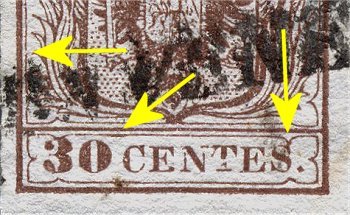 |
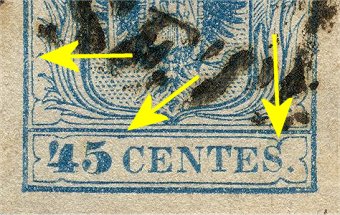 |
|
Fig.
1 and 2: the main elements in common between the 30 and of the
45 centesimi
1) Small interruption of the thin internal frame line, at about 1/3 from the bottom 2) Thickening of the upper frame of the lower plug that contains the value, between the numbers ("0" or "5") and the word "CENTES." 3) The "S" of "CENTES" touches the internal flap of the upper plug |
|
I already mentioned how the insertion of the "45" value in place of the "30" left quite evident (just to say so; in reality we are dealing with small details...) its own marks. Some of them are linked to the single position of the stamp in the sheet, while one repeats itself constantly on several values (Fig. 3).
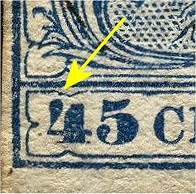
Fig. 3: small color dot in the plug flap.
It is noted often to the left above the number "4"
It's in fact a remaining mark of the previous number "3"
In other cases the chisel and insertion of the value have left even more evident marks... (Fig. 4 and 5).
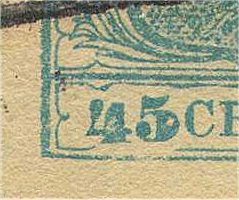
Fig. 4: the value "45" is much lower, specially the number
"4"
The lower plug is totally missing because it has been chiseled
during the insertion of the new value
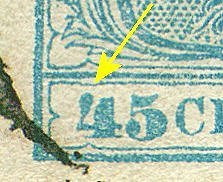
Fig. 5: flap over the value "45" completely "flattened"